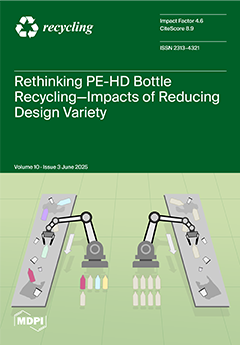The meat industry is one of the main sources of organic waste in the food processing sector. Due to their high content of biodegradable organic matter, these wastes represent a potentially valuable resource for the development of recycling and valorization processes, particularly with regard to the circular economy and environmental sustainability. The present study aimed at assessing the potential of natural sheep casings waste (NSCW) as a source of nitrogen for promoting the growth and lipid production of
Scenedesmus rubescens MDP19, a marine microalga isolated from the Mediterranean coastline of northern Morocco. For this purpose, we evaluated the effects of different NSCW concentrations (0.25–5 g L
−1) on the microalga growth, its ability to utilize organic waste components (proteins, amino acids, and carbohydrates) as nutrients, and its efficiency in eliminating nitrogen and phosphorus. Lipid and pigment contents were determined using colorimetric methods, and their composition was analyzed by high-performance liquid chromatography coupled with atmospheric pressure chemical ionization mass spectrometry (HPLC-APCI-MS/MS). The results showed that
S. rubescens MDP19 achieved the highest biomass production of 1.737 g L
−1 at an NSCW concentration of 5 g L
−1. This strain removed 33.70–47.63% of protein, 71.84–87.62% of amino acids, 41.9–92.97% of carbohydrates, 59.72–99.30% of nitrogen, and 80.74–99.10% of phosphorus. Furthermore,
S. rubescens MDP19 showed a significantly enhanced lipid content (68.11%) at an NSCW concentration of 0.5 g L
−1. At this concentration, the lipid composition of
S. rubescens MDP19 was particularly complex, including monounsaturated and polyunsaturated fatty acids, digalactosyldiacylglycerols, sulfoquinovosyldiacylglycerols, phosphatidylglycerols, and acylglycerols. The pigment profile includes neoxanthin, canthaxanthin, lutein, chlorophyll a, geranylgeranyl chlorophyll a, chlorophyllide b, hydrochlorophyllide b, and pheophytin a. These results indicate that natural sheep casings waste represents a promising source of nitrogen, reducing the need for nutrient supplementation in microalgae production. This approach not only offers a sustainable and economical alternative for optimizing microalgae cultivation but also contributes to the valorization of organic waste, thus supporting more ecological and responsible practices.
Full article





